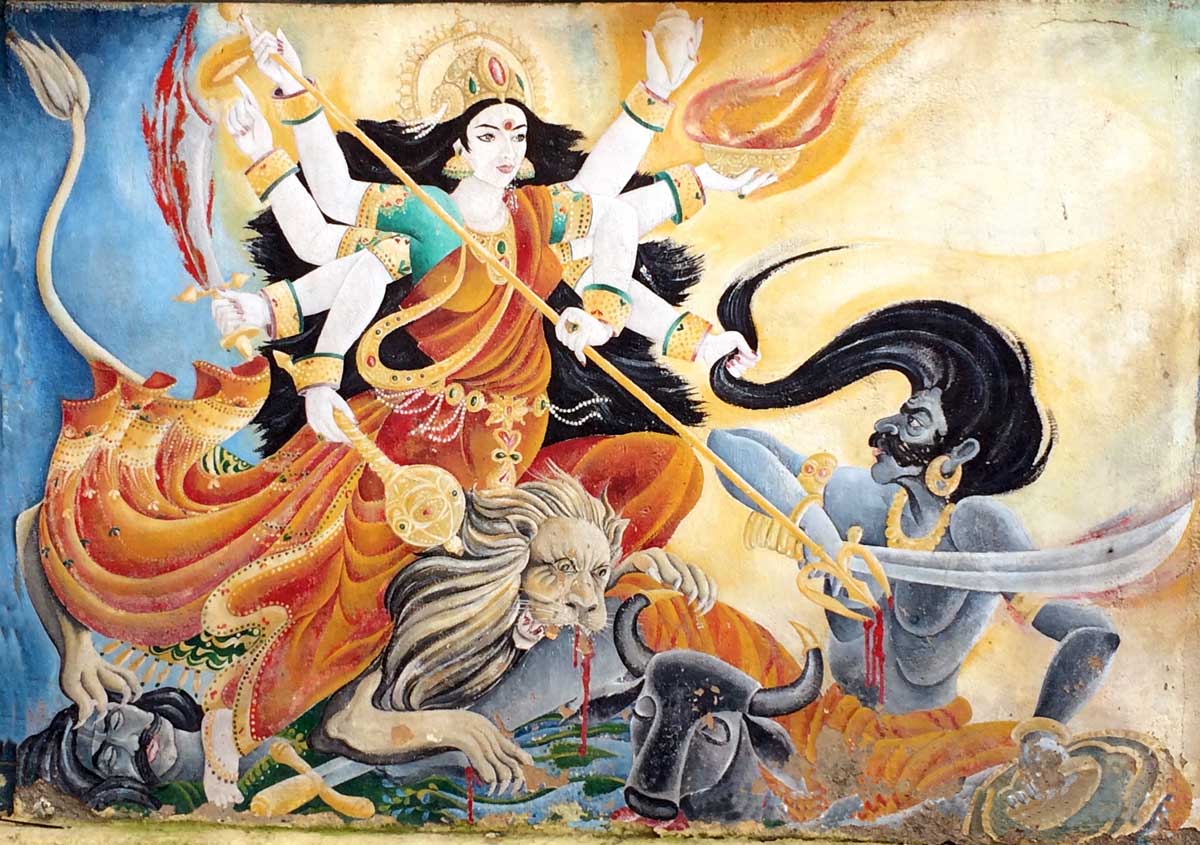
Mural of Durga at Pashupathninath in Nepal (photo by Laura Amazzone)"
As we face the many ecological, political, social, and religious crises of these shifting times, a 1500 year old myth, the Devi Mahatmya and the
millennia-old ritual worship of the Great Goddess Durga provide philosophical and spiritual insight into the powers that can aid us in the deep process of
transformation which we face both globally and personally.
Durga is a Goddess of Strength and Justice who brings compassion, peace, calm and order to the chaos, destruction and conflict in any situation. She
appears to us on her tiger, looking completely serene and composed, dressed in a red silk sari and carrying various weapons and tools in her eight to
eighteen arms.
In the Hindu traditions of South Asia, Durga is the Divine Mother Goddess who presides over the seasons of life, death, and birth. To many, She is simply
DEVI, which means ‘Goddess’ and comes from the sanskrit ‘Deva’, which means ‘to shine’.
Durga is the Great Mother who helps us remove the limitations and emotional and mental obscurations that prevent us from shining the Divine Light we all
carry within our hearts.
Durga, which means the invincible, unconquerable, and unassailable one, is the name this powerful and courageous Goddess takes after Her defeat of the
buffalo-headed demon Durgama. She teaches us that the divine light of truth and wisdom will always prevail over disorder and pain.
Durga’s myth, the Devi Mahatmya, dates to the 5th century CE and is an epic tale of the triumph of wisdom over ignorance. The Devi Mahatmya is a
dramatic narration of the different battles the Great Goddess fights to stop all that is threatening the balance and harmony between humans and nature. Its
various chapters describe how only the Great Goddess can stop the asuras (demons) that are causing so much bloodshed, violence and destruction on the
earth. The demons represent the afflicted ego qualities in humans and Devi confronts the demons of arrogance, pride, hypocrisy, greed, rage,
discrimination, injustice and more.
Throughout the story, Durga appears in Her many great manifestations as Parvati, Ambika, Mahalakshmi, Chandika and others. She takes various divine forms
to engage in each battle and meet whatever threatening egoic energies appear.
We are reminded again and again how these asuras (demons) are the afflicted ego and all that is happening on the mythic battlefields shows the ways the
mind and ego try to trick, deceive, even attack ourselves and others.
Durga’s many weapons and tools give us insight into what is needed to face our struggles. With Her composure and conviction we can face whatever stands
before us and pray and work for justice to prevail. Her bells brings clarity and removes negativity, Her sword severs attachments and brings
discrimination, Her shield protects and reflects back any attacks or vicious criticism. Her club smashes injustice and subdues the over-analytical and
judgmental mind. Her spear penetrates to the heart of any matter helping us locate the central truths and act or decide from there.
Her iconography and mythology offer many insights into how to work with imbalances and disturbances in the human psyche that inevitably will manifest
outwardly creating dysfunction, disharmony and at worst, violence and destruction. Tantric, yogic and Hindu devotees and practitioners who feel a
connection to Durga work with her throughout the year, but there is also an annual festival that gives the entire community the opportunity to honor Durga
through remembering and reenacting this 1500 year old myth ritualistically and symbolically.
Navaratri, Durga Puja, Dashain
Each autumn, Durga’s millennia-old festival called Navaratri, Durga Puja or Dashain is celebrated all over the Hindu world and people of all religious and
spiritual backgrounds join in. For nine nights and ten days Durga’s epic myth is recited and rituals are performed to invoke, propitiate and honor Her
various forms. At its root the Durga Puja is an ancient agricultural festival celebrating the harvest as well as a time of ritualistically preparing for
the coming winter season and the darkness it brings. It is a time when the cycles of life, death and birth are reenacted through the myth and rituals and
Durga is celebrated as the source and force behind these cyclical energies and all of existence as she has been for thousands of years.
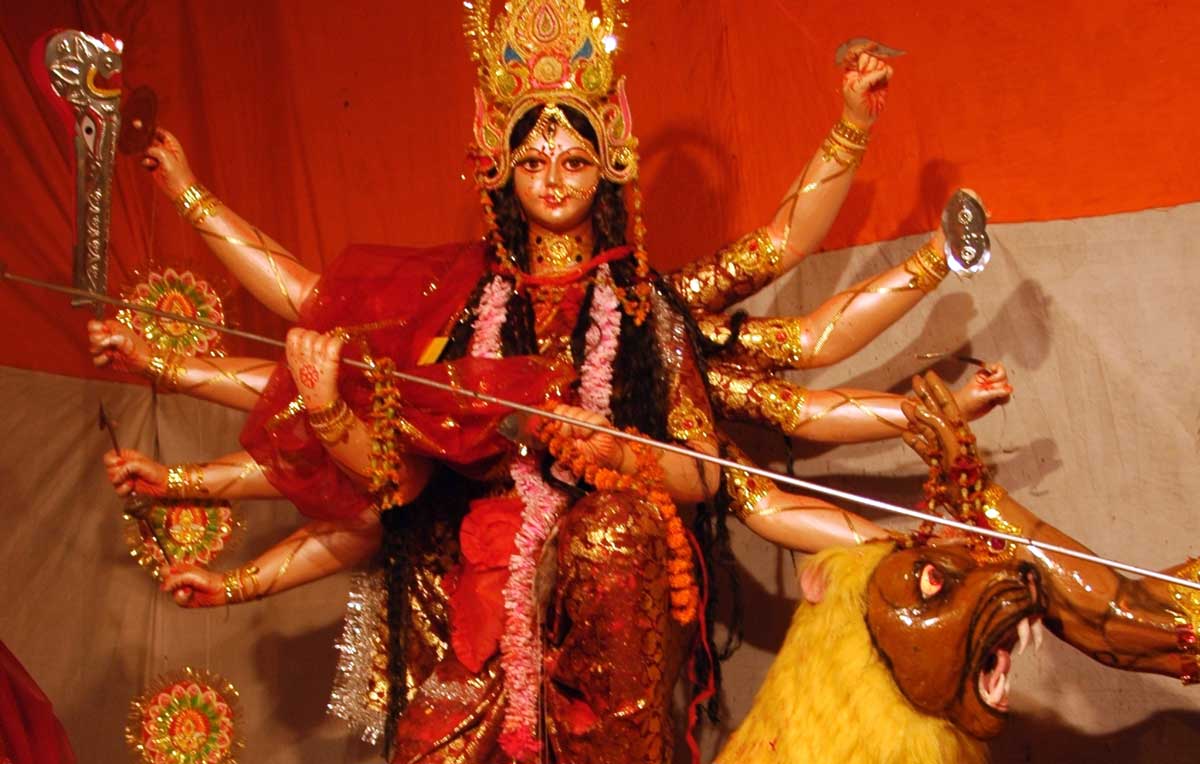
Durga at Ram's Durga Pandal - photo by Laura Amazzone
In preparation for Durga Puja (Ritual), Navaratri (Nine Nights) or Dashain (Nepali), temporary shrines or ‘pandals’ are created in each village and in the
larger towns and cities shrines are created in the various districts. The shrines host murti (images or representations) of the Goddess made of straw and
clay that are colorfully painted, lavishly dressed and richly adorned. The Goddess and Her entourage: Mahalakshmi, Mahakali, Mahasaraswati, and even the
elephant-headed God Ganesh all appear for these nine nights to assist Durga’s cyclical return and renewal of the cosmic energies behind existence.
Each day during the festival ritual, local devotees visit the temporary shrine or a local temple housing Her powerful image. They bring offerings of
incense, marigolds and hibiscus flowers, fruits, nuts and other special foods for the Goddesses who appear not only in the Devi Mahatmya myth fighting
injustice and restoring balance but also in our own lives and communities. It is said she has a stronger presence at this time.
The rich mythical, ritualistic, and philosophical symbolism around Goddess Durga presents itself on many levels—for example the central object of worship
for the first day is a kalasha or sacred vessel or pot that is worshiped as the womb of the Goddess. The kalasha also represents the Cosmos and the
generative and creative powers of Goddess as well as women.
It also relates to the fertility of the earth and barley seeds are planted around it in a bed of fresh soil on the family altar on the first day of the
festival. Over the festival days, the myth will be recited, rituals honoring Durga in Her various forms will be performed and the seeds will grow into
small shoots that are a symbol of the blades of Durga’s swords from her battles.
On a philosophical level, the way the asuras or demons are portrayed in the myth outlines our universal struggles with negativity, pessimism, corruption,
greed, and fear.
Durga assumes various forms that have the specific Shakti (power or energy) to confront and transform whatever demon she faces. We learn in the beginning
chapter that She is Mahamaya, the Great Goddess of Illusion. She who conceals and reveals. She conceals our light, the true wisdom energy within us and
others, and She is the power that reveals it to us. It is all Her grace and this myth shows us how She is ultimately the great Shakti (power) behind it
all.
The festival follows the structure of the myth and breaks up the festival period into three days for each of the three forms of Durga relating to
Destruction, Life and Creation.
We can look to these Goddesses as guides through our own difficulties and fears as well as what to expect to have to confront and transform when we commit
to the spiritual path with the aim of liberation from the bondage of our conditioning.
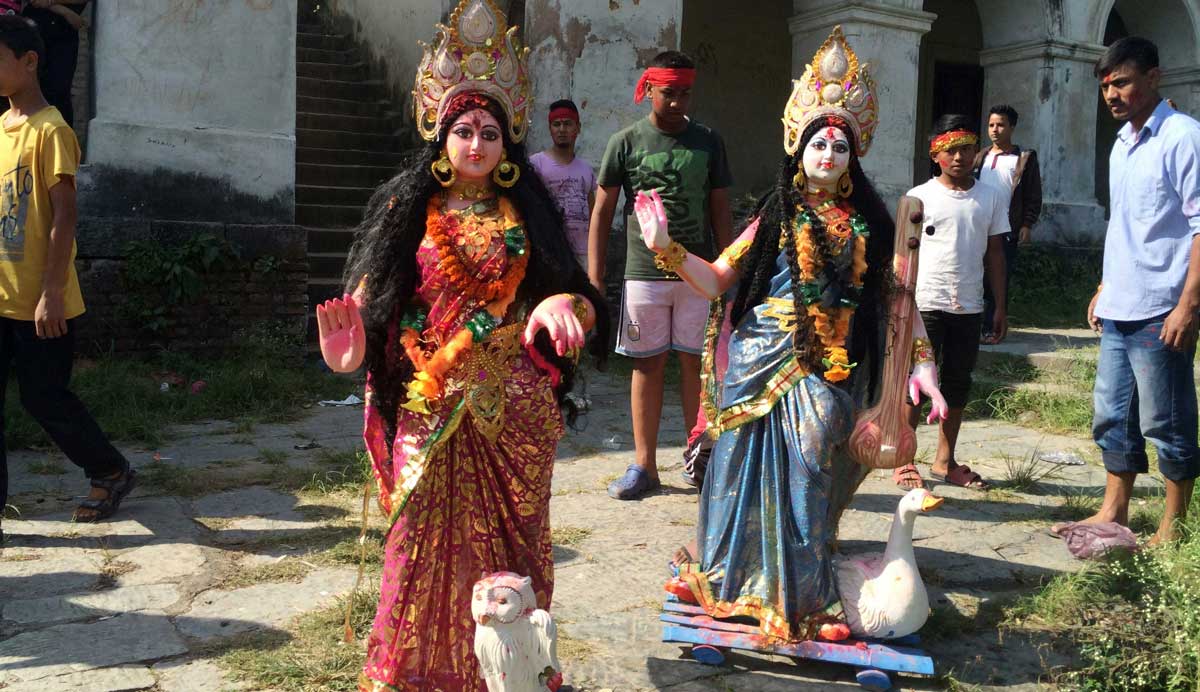
Lakshmi and Saraswati - Chobar Tika Day- photo by Laura Amazzone
Mahasaraswati appears on both the first and ninth days of the festival and depending on which version of the myth you consider, She could be present in
either position. First we find Her energy in the ritual of installing the Goddess into the Kalasha or Sacred Vessel-called Ghatasthapana. As we have seen,
the pot is symbolic of the universe and also the female womb - this initial ritual honors the potency of the cosmic and human female womb and its power to
give birth not only to a child but also to so many creative manifestations.
On the ninth day all of one’s tools, instruments, and books are placed on the altar and receive offerings from the participants and blessings from the
Goddess.
Mahasarwati reminds us of the purity of heart and spirit. She is the wisdom aspect and when we honor Her on the final days of the festival we are
celebrating the spiritual fruits we have received from our devotion and practice. When we worship Her in the first three days, we can feel Her Shakti
purifying our minds, bodies and hearts and preparing us to go deeper into our true essence.
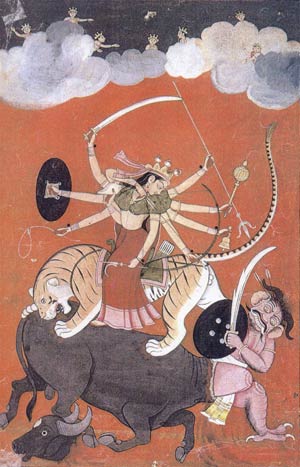
Goddess Durga fighting with Mahishasura
Devi appears as Mahalakshmi in her battle with Mahisuramardini, the buffalo-headed demon who shape shifts into many different forms: elephant, man, demon.
In these chapters we witness the dangers of rage that is blinding and the relentless nagging of the mind to do do do. We see how the mind kicks
and screams and throws itself about if it does not get what it wants. Mahisuramardini becomes more and more enraged as the Goddess is untouchable and
invincible to all his advances. Mahalakshmi teaches us about our desires and passions and we are invited to consider the source of these desires. Are they
grounded in the heart or do they come from the ego and a fear of lack, or perhaps an urgent need to grasp and possess?
She appears as Mahakali to destroy the demons Nishumbha and Shumbha and Raktabija.
The theme of these final and fiercest battles shows the way the mind works and how negative thoughts feed on negative thoughts creating even more conflict
and tension.
In these chapters we read how every time one of Durga’s arrows hits the demon chief, the drop of blood falls to the ground and produces another demon. This
myth points to the ways our negative thoughts proliferate and cause only more chaos and harm. Only Goddess Kali the great liberator and destroyer can
conquer these out of control energies.
In these final chapters, we also get a glimpse of Durga’s other Shakti - a collective of eight Goddesses known as the Matrikas who assist specifically with
overcoming certain emotions. When the battle became especially intense, Durga summoned these Goddesses from Her very being, for they are Her Shakti or
powers, and they flew out of Her third eye and onto the battlefield to help slay the demons. The appearance of the Matrikas reminds us of the many
different powers we have within ourselves to call on at any time. We can also understand them as the power of the community who come together and share
their various skills and gifts to take on and transform any threatening and destructive situation.
Mahasaraswati, Mahalakshmi and Mahakali are the three main forms of Goddess Durga that hold prominence during Durga Puja and around which both the myth and
festival are structured. Through participating in the Durga puja rituals, chanting her myth, and meditating on Her indestructible essence and forms, we can
experience how Durga helps us calmly face our fears, our emotional and mental struggles, and all of life's difficulties. Durga is the Great Liberator. In
fact, She is known as the Goddess who liberates any oppressed energies we may be feeling within ourselves and in our lives. She wants us to live freely and
fully from our hearts. She wants us to remember our inherently Divine Nature. She wants us to know that no matter how painful or upsetting a situation is,
She will come when we call Her.
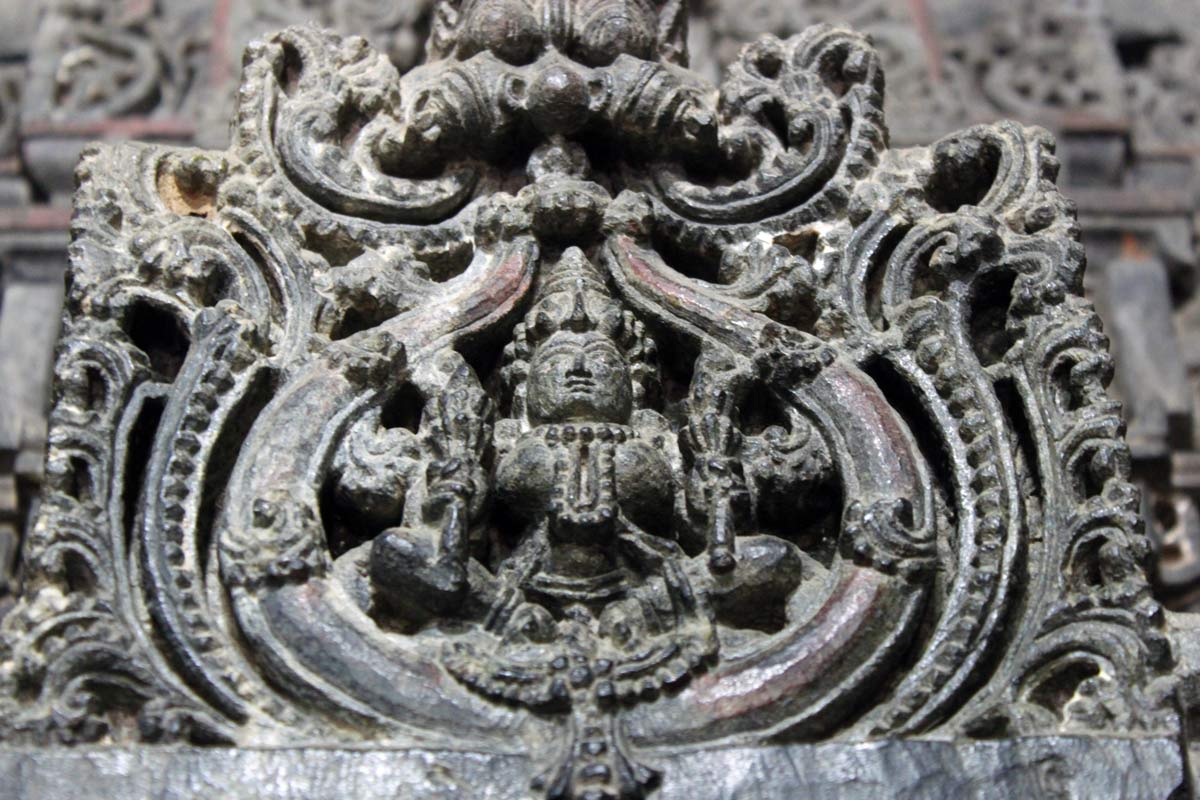
photo by Vikram Zutshi
When called upon, Goddess Durga will lead us through situations that feel insurmountable. It is no wonder one of the meanings of Her name is fortress.
Durga reminds us of the fortress we each carry within ourselves and can feel as a support when we need to fortify our emotional, physical, mental and
spiritual boundaries. She will show us how to work with whatever we are facing from a place of protection, equilibrium and trust. Durga has been described
as the center within the storm. As all the challenges and chaos spin around us, She can help us to find a place of refuge and stillness from which we can
act more consciously and compassionately. In this world where so much injustice and destruction prevails, we need Durga more than ever.